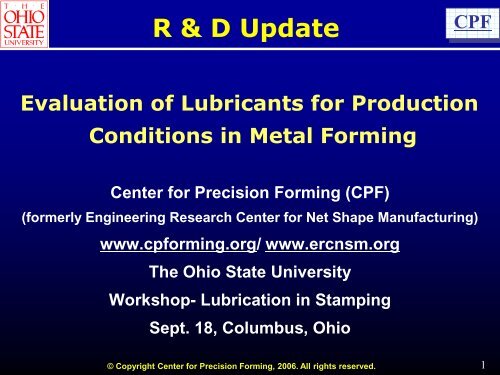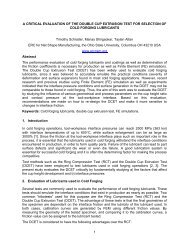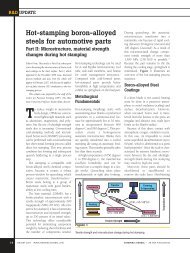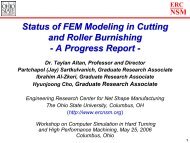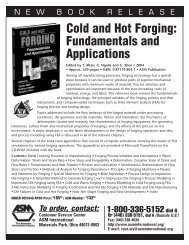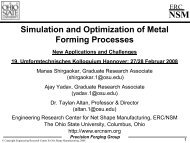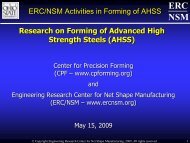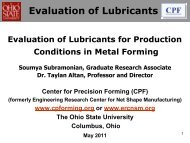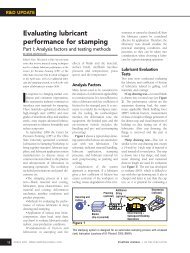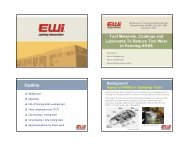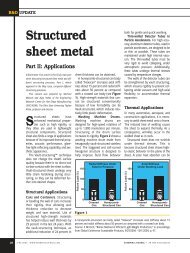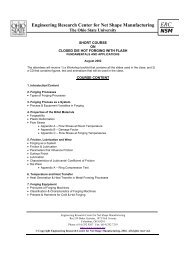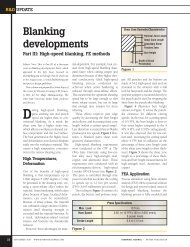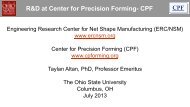Evaluation of Lubricants for Production Conditions in Metal
Evaluation of Lubricants for Production Conditions in Metal
Evaluation of Lubricants for Production Conditions in Metal
You also want an ePaper? Increase the reach of your titles
YUMPU automatically turns print PDFs into web optimized ePapers that Google loves.
R & D UpdateCPF<strong>Evaluation</strong> <strong>of</strong> <strong>Lubricants</strong> <strong>for</strong> <strong>Production</strong><strong>Conditions</strong> <strong>in</strong> <strong>Metal</strong> Form<strong>in</strong>gCenter <strong>for</strong> Precision Form<strong>in</strong>g (CPF)(<strong>for</strong>merly Eng<strong>in</strong>eer<strong>in</strong>g Research Center <strong>for</strong> Net Shape Manufactur<strong>in</strong>g)www.cp<strong>for</strong>m<strong>in</strong>g.org/ www.ercnsm.orgThe Ohio State UniversityWorkshop- Lubrication <strong>in</strong> Stamp<strong>in</strong>gSept. 18, Columbus, Ohio© Copyright Center <strong>for</strong> Precision Form<strong>in</strong>g, 2006. All rights reserved.1
Outl<strong>in</strong>eCPFObjectives – <strong>Evaluation</strong> <strong>of</strong> lubricants <strong>in</strong> metal <strong>for</strong>m<strong>in</strong>gprocesses./ Review <strong>of</strong> various tests.Tests to Evaluate <strong>Lubricants</strong> <strong>for</strong> Forg<strong>in</strong>gDouble Cup Extrusion Test <strong>for</strong> cold <strong>for</strong>g<strong>in</strong>gR<strong>in</strong>g Compression Test <strong>for</strong> cold & hot <strong>for</strong>g<strong>in</strong>gTests to Evaluate <strong>Lubricants</strong> <strong>for</strong> Stamp<strong>in</strong>gDeep Draw<strong>in</strong>g TestIron<strong>in</strong>g Test at elevated temperatureModified Limit<strong>in</strong>g Dome Height TestTests to Evaluate <strong>Lubricants</strong> <strong>for</strong> Hydr<strong>of</strong>orm<strong>in</strong>gThe Guid<strong>in</strong>g Zone / Expansion Zone Tests© Copyright Center <strong>for</strong> Precision Form<strong>in</strong>g, 2006. All rights reserved.2
Tests to Evaluate <strong>Lubricants</strong> <strong>for</strong> Forg<strong>in</strong>g- Double Cup Extrusion TestCPFDouble cup extrusion tool<strong>in</strong>g (ERC/NSM)The ratio <strong>of</strong> the cup heights,R ch =h 1 /h 2 , <strong>in</strong>creases with<strong>in</strong>creas<strong>in</strong>g coefficient <strong>of</strong> friction(or friction factor, m)© Copyright Center <strong>for</strong> Precision Form<strong>in</strong>g, 2006. All rights reserved.3
Tests to Evaluate <strong>Lubricants</strong> <strong>for</strong> Forg<strong>in</strong>g- Double Cup Extrusion TestCPFPer<strong>for</strong>mance <strong>Evaluation</strong> Criteria:• Cup height ratio (R ch = h1 / h2) is used to rank lubricants.• Surface analysis on the cut specimen to <strong>in</strong>vestigate gall<strong>in</strong>g.• The friction factor (m) is determ<strong>in</strong>ed by compar<strong>in</strong>g experimentalresults and FE predictions <strong>of</strong> cup height ratio (R ch ) vs. stroke.h 1 h 2Initial billetFormed billet© Copyright Center <strong>for</strong> Precision Form<strong>in</strong>g, 2006. All rights reserved.4
Friction factor (m)Tests to Evaluate <strong>Lubricants</strong> <strong>for</strong> Forg<strong>in</strong>g- Double Cup Extrusion TestAlternatives to Z<strong>in</strong>c Phosphate Coat<strong>in</strong>g Based LubricationCPF0.080.070.060.050.040.030.020.010Z<strong>in</strong>c PhosphateCoat<strong>in</strong>g + SoapMECHOMATMCIZ-CoatDaidoAqualubThe per<strong>for</strong>mance comparison between z<strong>in</strong>c phosphate and thethree tested lubricants shows the potential <strong>for</strong> replac<strong>in</strong>g z<strong>in</strong>cphosphate <strong>for</strong> mild <strong>for</strong>g<strong>in</strong>g processes.© Copyright Center <strong>for</strong> Precision Form<strong>in</strong>g, 2006. All rights reserved.5
Tests to Evaluate <strong>Lubricants</strong> <strong>for</strong> Forg<strong>in</strong>g- Double Cup Extrusion TestCPFList <strong>of</strong> Recently Published Reports and Papers1. Schrader, T., Shirgaokar, M. and Altan, T., “Analysis <strong>of</strong> Double Cup Extrusion Test <strong>for</strong><strong>Evaluation</strong> <strong>of</strong> <strong>Lubricants</strong>”, Proceed<strong>in</strong>gs, Int. Sem<strong>in</strong>ar on Precision Forg<strong>in</strong>g, Mar. 21-24,Nara, Japan, Paper No. 576 (2006).2. Report No. ERC/NSM-05-R-13 entitled “<strong>Evaluation</strong> <strong>of</strong> Lubricant Per<strong>for</strong>mance <strong>in</strong> ColdForg<strong>in</strong>g operations and Fundamental study <strong>of</strong> the Double Cup Extrusion Test” (2005).3. Report No. ERC/NSM-05-R-13 entitled “A Cold Form<strong>in</strong>g Coat<strong>in</strong>g / Lubricant Study (ACollaborative Study between Henkel Surface Technologies and The Ohio StateUniversity)” (2005).4. Report No. F/ERC/NSM-02-R-85 entitled “Development <strong>of</strong> Replacements <strong>for</strong>Phoscoat<strong>in</strong>g used <strong>in</strong> Forg<strong>in</strong>g, Extrusion and <strong>Metal</strong> Form<strong>in</strong>g Processes” (2002)5. Kim, H., Shr<strong>in</strong>iwas, P. and Altan, T "<strong>Evaluation</strong> <strong>of</strong> New <strong>Lubricants</strong> <strong>for</strong> Cold Forg<strong>in</strong>gWithout Z<strong>in</strong>c Phosphate Coat<strong>in</strong>g", Proceed<strong>in</strong>gs <strong>of</strong> the International Cold Forg<strong>in</strong>g Group37th Plenary Meet<strong>in</strong>g, Istanbul, Turkey, Sep. 13-15, Paper No. 525-1 (2004).6. Gariety, M., Ngaile, G. and Altan. T. "<strong>Evaluation</strong> <strong>of</strong> Environmentally Friendly <strong>Lubricants</strong><strong>for</strong> Cold Forg<strong>in</strong>g Processes", submitted to the International Journal <strong>of</strong> Mach<strong>in</strong>e Tool andManufacture, July, Paper No. 525 (2003).© Copyright Center <strong>for</strong> Precision Form<strong>in</strong>g, 2006. All rights reserved.6
Tests to Evaluate <strong>Lubricants</strong> <strong>for</strong> Forg<strong>in</strong>g- R<strong>in</strong>g Compression TestCPF• <strong>Evaluation</strong> <strong>of</strong> lubricant per<strong>for</strong>mance (RT ~ 200ºC)• Investigation <strong>of</strong> the effect <strong>of</strong> surface topography (i.e. surfaceroughness or the real contact area ratio) on friction and lubrication• Investigation <strong>of</strong> friction <strong>in</strong> function <strong>of</strong> stroke and locationR iR i- The reduction <strong>of</strong> <strong>in</strong>ner diameter (R i ) <strong>in</strong>dicates the friction on r<strong>in</strong>g surface© Copyright Center <strong>for</strong> Precision Form<strong>in</strong>g, 2006. All rights reserved.7
Tests to Evaluate <strong>Lubricants</strong> <strong>for</strong> Forg<strong>in</strong>g- R<strong>in</strong>g Compression TestEffect <strong>of</strong> die temperature on lubrication conditionTest <strong>Conditions</strong>F<strong>in</strong>al R<strong>in</strong>g GeometriesCPFRC1Lubricated (top & bottom)TD:150 °CBD, R<strong>in</strong>g: 25 °CSpeed: 65mm/secRC2ID: 19.78 mm (top), 20.56 mm (bottom)ID: 19.81 mm (top & bottom)Lubricated (top & bottom)TD,BD,R<strong>in</strong>g:150 °CSpeed: 65mm/secDry (top)Lubricated (bottom)TD,BD,R<strong>in</strong>g:150 °CSpeed: 65mm/secRC3ID: 18.71 mm (top), 19.98 mm (bottom)[ Note: TD = the top die, and BD = the bottom die, <strong>in</strong>itial r<strong>in</strong>g dimensions: OD / ID / height = 35/18/18 mm,made from AISI 1018 HR steel ]8© Copyright Center <strong>for</strong> Precision Form<strong>in</strong>g, 2006. All rights reserved.
Tests to Evaluate <strong>Lubricants</strong> <strong>for</strong> Forg<strong>in</strong>g- R<strong>in</strong>g Compression TestCPFList <strong>of</strong> Recently Published Reports1. Report No. PF/ERC/NSM-05-R-14 entitled “Investigation <strong>of</strong> Friction <strong>in</strong> <strong>Metal</strong>Form<strong>in</strong>g Us<strong>in</strong>g The R<strong>in</strong>g Compression Test (Phase I: Effects <strong>of</strong> SurfaceTopography on Friction)” (2005).2. Report No. PF/ERC/NSM-04-R-28 entitled “Investigation <strong>of</strong> the Effect <strong>of</strong>Temperature on Lubrication and Flow Stress <strong>in</strong> Cold Form<strong>in</strong>g Us<strong>in</strong>g the R<strong>in</strong>gCompression Test” (2005).3. Report No. PF/ERC/NSM-04-R-21 entitled “Micro-Tribology <strong>for</strong> <strong>Metal</strong> <strong>for</strong>m<strong>in</strong>g – ALiterature Review” (2004).4. Altan, T. and Kim, H., “Experimental and Numerical Studies on Friction &Lubrication <strong>in</strong> <strong>Metal</strong> Form<strong>in</strong>g Processes”, submitted to Proceed<strong>in</strong>gs <strong>of</strong> the NSFDesign, Service, and Manufactur<strong>in</strong>g Grantees and Research Conference, St.Louis, Missouri, July (2006).© Copyright Center <strong>for</strong> Precision Form<strong>in</strong>g, 2006. All rights reserved.9
<strong>Evaluation</strong> <strong>of</strong> Stamp<strong>in</strong>g <strong>Lubricants</strong>-System ApproachStamp<strong>in</strong>g process as a system (e.g., the deep draw<strong>in</strong>g process)CPF1. Workpiece material / Blank2. Tool<strong>in</strong>g3. Interface4. De<strong>for</strong>mation zone5. Equipment6. Part7. Environment© Copyright Center <strong>for</strong> Precision Form<strong>in</strong>g, 2006. All rights reserved.10
Stamp<strong>in</strong>g lubricants <strong>in</strong> theautomotive <strong>in</strong>dustryCPFProcess with oil-based (wet) lubricantDecoil<strong>in</strong>g andcutt<strong>in</strong>gPre-Oil<strong>in</strong>g(optional)AdditionalOil<strong>in</strong>g(optional)Degreas<strong>in</strong>g(optional)Stack<strong>in</strong>gBlanks(dry orpre-oiled)Deep Draw<strong>in</strong>g +subsequentblank<strong>in</strong>goperations[Courtesy: M. Pfestorf, 2005, BMW ]© Copyright Center <strong>for</strong> Precision Form<strong>in</strong>g, 2006. All rights reserved.11
Stamp<strong>in</strong>g lubricants <strong>in</strong> theautomotive <strong>in</strong>dustryCPFProcess with dry-film lubricantDecoil<strong>in</strong>g / Recoil<strong>in</strong>gwith Lube coat<strong>in</strong>g byimmersion or spray<strong>in</strong>gDecoil<strong>in</strong>gand cutt<strong>in</strong>gStack<strong>in</strong>gBlanksDeep Draw<strong>in</strong>g +subsequent blank<strong>in</strong>goperationsHot bath[Courtesy: M. Pfestorf, 2005, BMW ]© Copyright Center <strong>for</strong> Precision Form<strong>in</strong>g, 2006. All rights reserved.12
The Twist Compression Test (TCT)CPFr = 12.7 mmThe tool is rotated under axial <strong>for</strong>ce. Thetorque is measured. COF is calculated <strong>in</strong> realtime.© Copyright Center <strong>for</strong> Precision Form<strong>in</strong>g, 2006. All rights reserved.13
Scratch and Slider TestsCPFa) Ball scratch<strong>in</strong>g test[Carlsson et al. 2001]b) Slider-on-sheet test [Heideet al. 2003]© Copyright Center <strong>for</strong> Precision Form<strong>in</strong>g, 2006. All rights reserved.14
Strip Reduction TestCPFa) Strip reduction test[Olsson et al. 2004]b) Cross sectional view[Olsson et al. 2004]© Copyright Center <strong>for</strong> Precision Form<strong>in</strong>g, 2006. All rights reserved.15
Strip Draw TestsCPFa) Strip draw test[Vermerulen et al. 2001]b) Draw bead simulator <strong>for</strong>gall<strong>in</strong>g [Vermerulen et al.2001]© Copyright Center <strong>for</strong> Precision Form<strong>in</strong>g, 2006. All rights reserved.16
Tests to Evaluate <strong>Lubricants</strong> <strong>for</strong> Stamp<strong>in</strong>g- Deep Draw<strong>in</strong>g TestCPFDeep draw<strong>in</strong>g test was used successfully <strong>for</strong> evaluat<strong>in</strong>g lubricants byvarious European manufacturers. ERC/NSM is further develop<strong>in</strong>g this test<strong>for</strong> quantitative rank<strong>in</strong>g <strong>of</strong> lubricants.12 <strong>in</strong>chInitialblank6 <strong>in</strong>chDeepdrawn cupSchematic <strong>of</strong> ERC/NSM Draw<strong>in</strong>g Tool<strong>in</strong>g© Copyright Center <strong>for</strong> Precision Form<strong>in</strong>g, 2006. All rights reserved.17
Tests to Evaluate <strong>Lubricants</strong> <strong>for</strong> Stamp<strong>in</strong>g- Deep Draw<strong>in</strong>g TestCPFAs blank holder pressure (P b ) <strong>in</strong>creases, frictional stress () <strong>in</strong>creasesbased on Coulomb’s law.Schematic <strong>of</strong> deep draw<strong>in</strong>gCoulomb’s law where = the frictional shear stress the coefficient <strong>of</strong> frictionP = the blank holder pressure© Copyright Center <strong>for</strong> Precision Form<strong>in</strong>g, 2006. All rights reserved.P bb18
FE simulation <strong>of</strong> deep draw<strong>in</strong>g- Temperature distribution at the f<strong>in</strong>al drawn cupCPFSimulation parametersPunch diameter = 152.4 mmSheet diameter = 304.8 mmPunch velocity = 70 mm/secBHF = 300 KN(Sheet material : DP590 and Thickness=1.24 mm)[FEM Code: DEFORM-2D]© Copyright Center <strong>for</strong> Precision Form<strong>in</strong>g, 2006. All rights reserved.19
Tests to Evaluate <strong>Lubricants</strong> <strong>for</strong> Stamp<strong>in</strong>g- Deep Draw<strong>in</strong>g TestCPFPer<strong>for</strong>mance <strong>Evaluation</strong> Criteria:• The max. draw<strong>in</strong>g load atta<strong>in</strong>ed.• The max. applicable blank holder <strong>for</strong>ce without failure <strong>of</strong> thecup.• Measurement <strong>of</strong> draw-<strong>in</strong> length, Ld, or perimeter <strong>of</strong> flange <strong>in</strong>a drawn cup.• <strong>Evaluation</strong> <strong>of</strong> lubricant build-up on the die <strong>for</strong> dry filmlubricant.© Copyright Center <strong>for</strong> Precision Form<strong>in</strong>g, 2006. All rights reserved.20
Tests to Evaluate <strong>Lubricants</strong> <strong>for</strong> Stamp<strong>in</strong>g- Deep Draw<strong>in</strong>g TestCPF<strong>Lubricants</strong> are ranked based on the highest constant BHF thatcan be applied <strong>in</strong> the deep draw<strong>in</strong>g be<strong>for</strong>e the cup failsBHF = 50 tonsTest speed = 65 mm/secLoad-stroke curves <strong>of</strong> <strong>for</strong>med vs. fractured cups© Copyright Center <strong>for</strong> Precision Form<strong>in</strong>g, 2006. All rights reserved.21
Tests to Evaluate <strong>Lubricants</strong> <strong>for</strong> Stamp<strong>in</strong>g- Deep Draw<strong>in</strong>g TestCPFComparison <strong>of</strong> Draw-<strong>in</strong> length <strong>for</strong> various lubes tested under different BHF© Copyright Center <strong>for</strong> Precision Form<strong>in</strong>g, 2006. All rights reserved.22
Tests to Evaluate <strong>Lubricants</strong> <strong>for</strong> Stamp<strong>in</strong>g- Deep Draw<strong>in</strong>g TestCPFList <strong>of</strong> Recently Published Papers1. Kim, H. and Altan, T., “<strong>Evaluation</strong> <strong>of</strong> Dry Film <strong>Lubricants</strong> <strong>for</strong> Stamp<strong>in</strong>g under Realistic<strong>Production</strong> <strong>Conditions</strong>”, accepted to Stamp<strong>in</strong>g Journal, Mar. 2006 (Paper No. 579).2. Kim, H. and Altan, T., "<strong>Evaluation</strong> <strong>of</strong> Dry Film <strong>Lubricants</strong> <strong>for</strong> Automotive Applications - PartI: A General Review", R&D Update, Stamp<strong>in</strong>g Journal, September 2005, p.38 (Paper No.555-9).3. Kim, H. and Altan, T., “<strong>Evaluation</strong> <strong>of</strong> Dry Film <strong>Lubricants</strong> <strong>for</strong> Automotive Applications – PartII: The Iron<strong>in</strong>g Test”, R&D Update, Stamp<strong>in</strong>g Journal, to be published <strong>in</strong> October 2005(Paper No. 555-10).4. Kim, H. and Altan, T., “<strong>Evaluation</strong> <strong>of</strong> Dry Film <strong>Lubricants</strong> <strong>for</strong> Automotive Applications – PartIII: Test<strong>in</strong>g through Deep Draw<strong>in</strong>g”, R&D Update, Stamp<strong>in</strong>g Journal, to be published <strong>in</strong>November 2005 (Paper No. 555-11).5. Kim, H. and Altan, T., “Per<strong>for</strong>mance <strong>Evaluation</strong> <strong>of</strong> Tool Materials and <strong>Lubricants</strong> <strong>in</strong> Form<strong>in</strong>gGalvanized AHSS”, CIRP Annals, 2008, p. 299 (Paper No.611).6. Kim, H. and Altan, T., “Investigation <strong>of</strong> Gall<strong>in</strong>g <strong>in</strong> Form<strong>in</strong>g Galvanized AHSS Us<strong>in</strong>g TCT”,JMPT, 2008, p. 459 (Paper No. 605).© Copyright Center <strong>for</strong> Precision Form<strong>in</strong>g, 2006. All rights reserved.23
Tests to Evaluate <strong>Lubricants</strong> <strong>for</strong> Stamp<strong>in</strong>g- Deep Draw<strong>in</strong>g TestCPFList <strong>of</strong> Recently Published Papers (cont.)7. “Lubrication and Gall<strong>in</strong>g <strong>in</strong> Stamp<strong>in</strong>g <strong>of</strong> Galvanized AHSS.”Part I- Stamp<strong>in</strong>g Journal, Jan/Feb 2008, p. 22Part II- Stamp<strong>in</strong>g Journal, March 2008, p. 22Part III- Stamp<strong>in</strong>g Journal, April 2008, p. 18© Copyright Center <strong>for</strong> Precision Form<strong>in</strong>g, 2006. All rights reserved.24
Strip Draw<strong>in</strong>g Test (SDT)CPFThe strip draw<strong>in</strong>g test (SDT) was developed to test the higher grades <strong>of</strong>AHSS (DP780, TRIP780 and DP980), because the limited <strong>for</strong>mability <strong>of</strong>these steels makes the deep draw<strong>in</strong>g test difficult to conduct.© Copyright Center <strong>for</strong> Precision Form<strong>in</strong>g, 2006. All rights reserved.25
Strip Draw<strong>in</strong>g Test (SDT)CPFDimensions <strong>of</strong> strip:Length = 356 mmWidth = 25 mmWith prelim<strong>in</strong>ary FE simulations <strong>of</strong> SDT, four different die radii <strong>of</strong> 5, 8, 10and 12 mm were determ<strong>in</strong>ed to change the contact pressure <strong>in</strong> the range <strong>of</strong>110 ~ 260 MPa without any neck<strong>in</strong>g <strong>of</strong> strip.© Copyright Center <strong>for</strong> Precision Form<strong>in</strong>g, 2006. All rights reserved.26
Tests to Evaluate <strong>Lubricants</strong> <strong>for</strong> Stamp<strong>in</strong>g- Iron<strong>in</strong>g Test at the elevated temperatureCPFIron<strong>in</strong>g Test developed at ERC/NSM successfully reproducesproduction conditions (contact pressure up to 650 MPa (94.2ksi) and temperature up to 150ºC (302ºF) <strong>in</strong> a laboratory setup.a) Iron<strong>in</strong>g test at ERC/NSM, b) Iron<strong>in</strong>g die with heat<strong>in</strong>g deviceThe iron<strong>in</strong>g test was used to determ<strong>in</strong>e the per<strong>for</strong>mance <strong>of</strong> dryfilmlubricants under production conditions.© Copyright Center <strong>for</strong> Precision Form<strong>in</strong>g, 2006. All rights reserved.27
Iron<strong>in</strong>g Load [ton]Coat<strong>in</strong>g loss weight/unit area [g/m^2]Tests to Evaluate <strong>Lubricants</strong> <strong>for</strong> Stamp<strong>in</strong>g- Iron<strong>in</strong>g Test at the elevated temperatureCPFThe per<strong>for</strong>mance <strong>of</strong> lubricants is evaluated based on the follow<strong>in</strong>gevaluation criteria:• The maximum iron<strong>in</strong>g load atta<strong>in</strong>ed.• Surface topography <strong>of</strong> the ironed cups after test.• Cup side-wall th<strong>in</strong>n<strong>in</strong>g.• Temperature range at which the lubricant fails.• Coat<strong>in</strong>g weight loss or lubricant build-up on die.16.0014.00Lub BLub A65Initial coat<strong>in</strong>g weight per unit area: 6.5 g/m^212.0010.0048.006.004.00322.0010.000.00 10.00 20.00 30.00 40.00 50.000Stroke [mm]Lub A© Copyright Center <strong>for</strong> Precision Form<strong>in</strong>g, 2006. All rights reserved.Lub B28
Strip Draw<strong>in</strong>g / Strip Iron<strong>in</strong>g Test- Test ResultsCPFGalled die surface after test<strong>in</strong>g 40 specimens(20 draw<strong>in</strong>gs and 20 iron<strong>in</strong>gs)Draw<strong>in</strong>gIron<strong>in</strong>gPmax=116 MPaPmax=450 MPa[FEM Code: PAM-STAMP 2G]Tested strip samples© Copyright Center <strong>for</strong> Precision Form<strong>in</strong>g, 2006. All rights reserved.29
Strip Draw<strong>in</strong>g / Strip Iron<strong>in</strong>g Tests- Micrographs <strong>of</strong> Die Surfaces after testsCPF© Copyright Center <strong>for</strong> Precision Form<strong>in</strong>g, 2006. All rights reserved.30
Tests to Evaluate <strong>Lubricants</strong> <strong>for</strong> Stamp<strong>in</strong>g- Iron<strong>in</strong>g Test at the elevated temperatureCPFList <strong>of</strong> Recently Published Papers1. Chandrasekharan, S., Palaniswamy, H., Ja<strong>in</strong>, N. and Altan, T "<strong>Evaluation</strong> <strong>of</strong>Stamp<strong>in</strong>g <strong>Lubricants</strong> at Various Temperature Levels us<strong>in</strong>g the Iron<strong>in</strong>g Test", TheInternational Journal <strong>of</strong> Mach<strong>in</strong>e Tools & Manufacture, November 2003 (PaperNo. 539)2. ERC/NSM "<strong>Evaluation</strong> <strong>of</strong> Stamp<strong>in</strong>g <strong>Lubricants</strong> us<strong>in</strong>g the Iron<strong>in</strong>g Test", R&DUpdate, Stamp<strong>in</strong>g Journal, November/December, 2003, p.50 (Paper No. 501-6)© Copyright Center <strong>for</strong> Precision Form<strong>in</strong>g, 2006. All rights reserved.31
Tests to Evaluate <strong>Lubricants</strong> <strong>for</strong> Hydr<strong>of</strong>orm<strong>in</strong>g- The Guid<strong>in</strong>g Zone TestCPFFriction Test <strong>for</strong> the Guid<strong>in</strong>g ZoneThis test is based on pressuriz<strong>in</strong>g the tubular specimen to the requiredpressure level and push<strong>in</strong>g it through a cyl<strong>in</strong>drical die. This tool<strong>in</strong>g usesviscous material to pressurize the tube <strong>in</strong>stead <strong>of</strong> hydraulic oil.Test results© Copyright Center <strong>for</strong> Precision Form<strong>in</strong>g, 2006. All rights reserved.32
Tests to Evaluate <strong>Lubricants</strong> <strong>for</strong> Hydr<strong>of</strong>orm<strong>in</strong>g- The Guid<strong>in</strong>g Zone TestCPF© Copyright Center <strong>for</strong> Precision Form<strong>in</strong>g, 2006. All rights reserved.33
Tests to Evaluate <strong>Lubricants</strong> <strong>for</strong> Hydr<strong>of</strong>orm<strong>in</strong>g- The Expansion Zone TestCPF© Copyright Center <strong>for</strong> Precision Form<strong>in</strong>g, 2006. All rights reserved.34
Protrusion height PH [mm]Protrusion height <strong>in</strong>dicates lubricant per<strong>for</strong>mance72.57271.57170.5DtubeDtubeTests to Evaluate <strong>Lubricants</strong> <strong>for</strong> Hydr<strong>of</strong>orm<strong>in</strong>gm- The Expansion Zone TestRcornerRcurv5mmSpecimen material SS304DtubeALtriIncreas<strong>in</strong>g <strong>in</strong>terface frictionCDBCPFDieTube7069.56968.5PH68Lub A Lub E Lub D Lub B No Lub<strong>Lubricants</strong>© Copyright Center <strong>for</strong> Precision Form<strong>in</strong>g, 2006. All rights reserved.35
Tests to Evaluate <strong>Lubricants</strong> <strong>for</strong> Hydr<strong>of</strong>orm<strong>in</strong>g–The Guid<strong>in</strong>g / Expansion zone TestsCPFList <strong>of</strong> Recently Published Reports and Papers1. Altan, T. and Kim, H., “Improvement <strong>of</strong> Tribological <strong>Conditions</strong> <strong>in</strong> Tube Hydr<strong>of</strong>orm<strong>in</strong>g by Us<strong>in</strong>gTextured Tubes”, submitted to Proceed<strong>in</strong>gs <strong>of</strong> the NSF Grantee's Conference, Scottsdale,Arizona, January 2005 (Paper No. 551).2. Ngaile, G., Gariety, M., and Altan, T. "Enhanc<strong>in</strong>g Tribological <strong>Conditions</strong> <strong>in</strong> Tube Hydr<strong>of</strong>orm<strong>in</strong>g byUs<strong>in</strong>g Textured Tubes", submitted to ASME Journal <strong>of</strong> Tribology, February 2004 (Paper No. 524).3. Ngaile, G., Jaeger, S., and Altan T. "Lubrication <strong>in</strong> Tube Hydr<strong>of</strong>orm<strong>in</strong>g-Part I., Transition andExpansion Zones", Journal <strong>of</strong> Materials Process<strong>in</strong>g Technology, Volume 146, Issue 1 , pp.108-115 (Paper No. 436).4. Siegert, K., et al "<strong>Evaluation</strong> <strong>of</strong> Lubrication <strong>in</strong> Tube Hydr<strong>of</strong>orm<strong>in</strong>g", <strong>Production</strong> Engr., vol. X, Nr. 1,2003, pp.23 (Paper No. 529).5. Ngaile, G., Jaeger, S., and Altan T. "Lubrication <strong>in</strong> Tube Hydr<strong>of</strong>orm<strong>in</strong>g-Part II., LDH Test and PearShaped Expansion Test" , Journal <strong>of</strong> Materials Process<strong>in</strong>g Technology, Volume 146, Issue 1,pp.116-123 (Paper No. 437).6. Cho, H. & Altan, T. "Determ<strong>in</strong>ation <strong>of</strong> Flow Stress and Interface Friction at Elevated Temperaturesby Inverse Analysis Technique" submitted to Journal <strong>of</strong> Materials Process<strong>in</strong>g Technology, Aug,2004 (Paper No. 520).7. Cho, H., Ngaile, G. and Altan, T. "Simultaneous Determ<strong>in</strong>ation <strong>of</strong> Flow Stress and InterfaceFriction by F<strong>in</strong>ite Element Based Inverse Analysis Technique, annals <strong>of</strong> CIRP, Vol.1, 2003,pp.221 (Paper No. 516).© Copyright Center <strong>for</strong> Precision Form<strong>in</strong>g, 2006. All rights reserved.36
Summary/ ConclusionsCPF• Laboratory tests used to evaluate the per<strong>for</strong>mance <strong>of</strong>lubricants (and additives) must emulate theproduction conditions at material/ tool <strong>in</strong>terface (i.e.pressure, relative velocity, temperature, surface/coat<strong>in</strong>g conditions).• Several tests are available <strong>for</strong> rapid and prelim<strong>in</strong>aryevaluation <strong>of</strong> lubricants (twist compression, stripdraw, stamp<strong>in</strong>g lubricant tester, etc.).• Deep draw<strong>in</strong>g and iron<strong>in</strong>g tests, conducted <strong>in</strong>production type equipment, can emulate the processconditions that exist <strong>in</strong> production.© Copyright Center <strong>for</strong> Precision Form<strong>in</strong>g, 2006. All rights reserved.37


